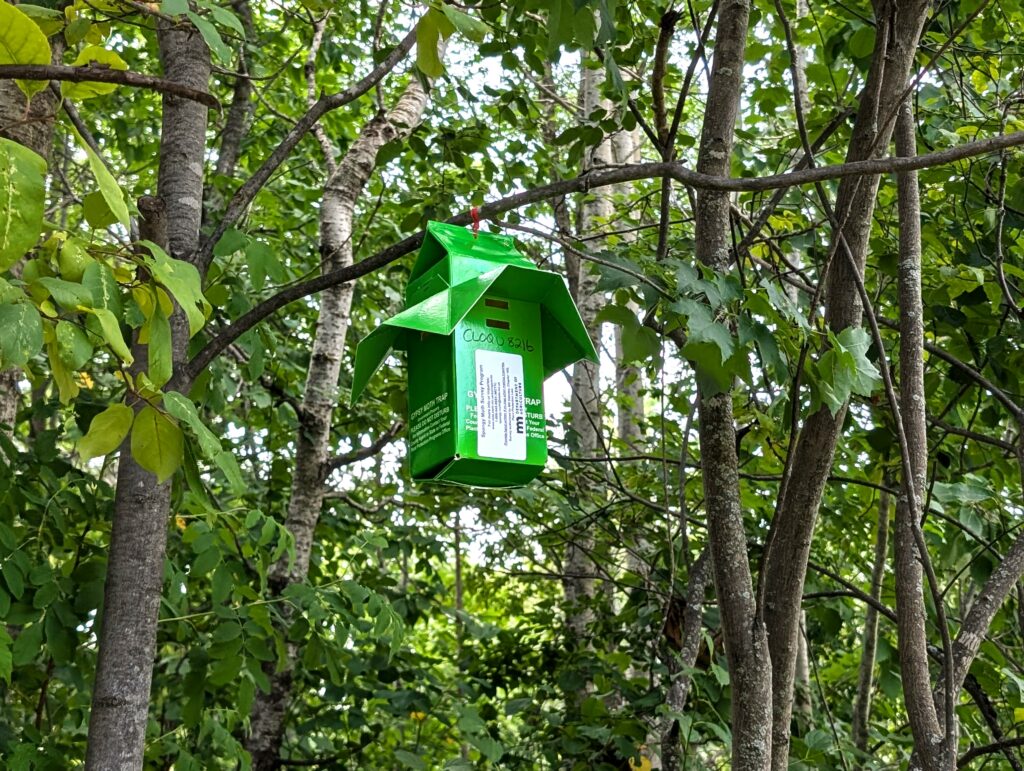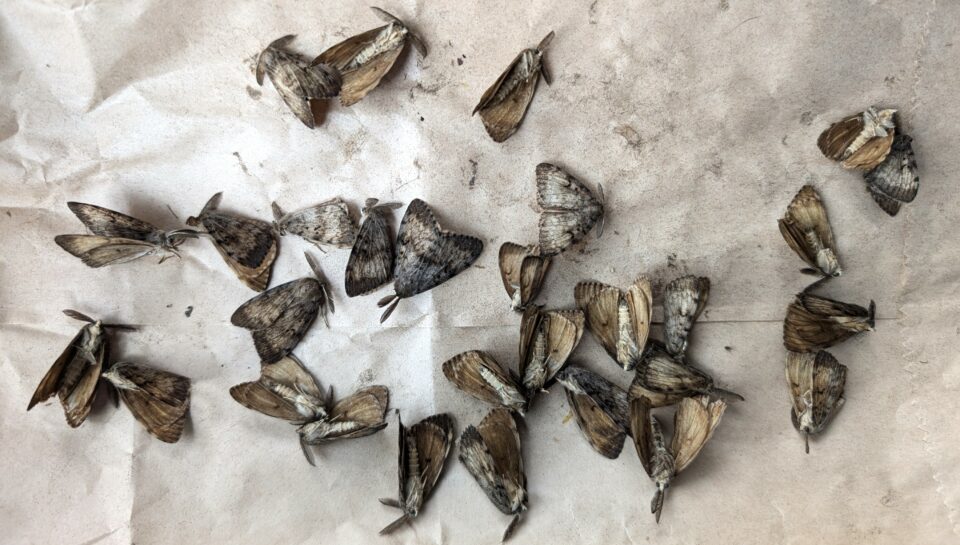I pulled over on a rural gravel road just west of Duluth on a cool, sunny mid-August day. I could see the bright green, milk-carton style cardboard moth trap from my car, hanging from the tree where I placed it two months prior.
With my staple remover handy, I started making my way through the tall grass to the trap. I was a few feet away when a fast movement caught my eye, fluttering over from a nearby clearing. A spongy moth! I watched as it danced around the trap for a second before swiftly disappearing inside. I noticed there were others moving within the trap as well, not yet overtaken by the pesticide strip.
I carefully collected the moths into a gallon bag, reset the trap, and began walking back to my car. Suddenly something small and soft hit me square in the face! I realized it was another spongy moth as it repeatedly bumped into the left pocket of my orange high visibility vest, where I’d been carrying pheromone strips earlier that day. I cupped my hand around it and added it to my bag, ready to be counted.
I applied to be a spongy moth surveyor through the Minnesota Department of Agriculture (MDA) last spring because I wanted to work outside in the woods, explore places I’ve never been, and make a positive difference. The United States has been battling this insect for over 150 years, and Minnesota is on the front line of the fight.
Never heard of the spongy moth? You’re not alone. Formerly known as the gypsy moth, the name was changed by the Entomological Society of America in 2023.
“Spongy moth (Lymantria dispar) is one of the oldest and most researched examples of an invasive species we have in North America,” states Natasha Northrop, Spongy Moth Survey Program Supervisor.
“The pest was brought in from Europe to Medford, MA in 1869 to attempt to crossbreed with the silkworm,” Northrop explains. They wanted to make silkworms more cold hardy, but it didn’t work, and the spongy moths escaped captivity. “They realized immediately it was going to be a problem and tried everything to try to contain it.”

The moths moved quickly, their hungry caterpillars defoliating large swaths of forest in the northeast for a hundred years. They can eat over 300 species of trees, leaving them vulnerable to disease. Eventually researchers learned how to detect and manage the species in order to slow the spread and damage.
A big milestone was learning how to create and produce large quantities of a spongy moth pheromone mimic. A lure containing the synthetic pheromone is placed inside moth traps, and it’s also used as part of the mating disruption management strategy.
“The MDA has been setting early detection traps for spongy moth since the mid-1970s,” Northrop states. “The first infestation was found and treated in St. Paul in 1980. Hundreds of start up populations have been detected and treated since then, effectively and significantly slowing the spread into the state and protecting other states west of Minnesota.”
“We now have a national multi-tiered strategy as defined by the USDA National Spongy Moth Management Program to, 1) eradicate isolated populations way ahead of the advancing front, 2) suppress high density populations in the generally infested / quarantined areas, and 3) limit/slow the spread in the transition zone in between.”
Trapping surveys and analysis of data collected determine areas to be treated. Delivered via low flying airplane, treatments come in two forms. One uses the aforementioned pheromone mimic to confuse the males so they can’t locate females. The other utilizes a bacteria found naturally in soil called Btk (Bacillus thuringiensis kurstaki), which kills young spongy moth caterpillars when they consume it. Neither treatment is harmful to other animals or plants.
This treatment strategy has slowed the spread of this destructive pest by over 60%, and economic analysis shows the program has an impressive benefit-to-cost ratio of 4:1.
Male spongy moths can be identified by their feathery antennae, gray-brown coloration with dark zig-zag patterning, and distinctive “comma” markings on their wings that also appear on the underside. They spend their two weeks of adult life flying erratically along the edges of forests and fields searching for females, which are larger and lighter in color with much thinner antennae. Adult moths do not eat – this stage of their lifecycle is meant only for reproduction.
Though females have wings, they are too heavy to fly. They crawl up a nearby tree, fence, building, or other structure, and wait. Their pungent pheromones can attract a male from up to a mile away. Once mating has taken place, they produce a soft mass containing hundreds of eggs that will overwinter and hatch in the spring.

The tiny larva use a strategy called ‘ballooning’ which allows them to ride a silk thread on the wind to land on a tree and begin feeding. Strong winds can potentially send them over a mile.
The buff colored spongy egg masses are the primary way spongy moths spread, however – transported unknowingly by people. “Outdoor household articles, vehicles, campers, logs, firewood, etc. are all potential vectors for transporting spongy moth egg masses or other life stages,” Northrop says.
Both Cook and Lake counties have been quarantined since 2014, which means the spongy moth is well established, and the movement of many items from the area is regulated. This includes materials like logs and pulpwood, but also Christmas trees and wreaths, nursery stock, and the personal outdoor items previously mentioned.
“It’s the law for people to self-inspect and remove spongy moth life stages if they are bringing any of these articles from a quarantined county into a non-infested county,” Northrop explains. “A self-inspection checklist is available on the MDA website.”
That means anyone living in or visiting Cook and Lake counties should be inspecting their vehicles and outdoor equipment before traveling out of the area.
“Spongy moth is not yet established in most of Minnesota,” Northrop says. Outside of the quarantine area, the public is unlikely to notice them. “It’s hard to say exactly when the whole state will be considered infested, but we’re doing our best to delay establishment for as long as possible,” she continues. “The goal spread rate is ~5 miles or less per year with the STS (Slow the Spread) program in place.”
If you do notice a spongy egg mass or other evidence of spongy moth activity, please report it using the Report-A-Pest online form from the MDA website, email reportapest@state.mn.us, or call 1-888-545-6684. Emailing photos is especially helpful!
Please also leave spongy moth detection survey traps in place if you see them, and call the number on the trap with any questions. We are working hard to protect our natural resources from this invasive pest, and the information gathered from the annual survey helps ensure our forests stay healthy for generations to come!—Dana Johnson
Check out these resources for more information:
MDA’s Spongy Moth Program: www.mda.state.mn.us/spongymoth
National Slow the Spread (STS) Foundation – www.slowthespread.org




